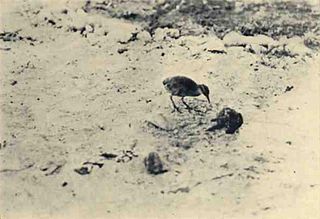The Calayan rail is a flightless bird of the rail, moorhen, and coot family (Rallidae) that inhabits Calayan Island in the Philippines. It is the only member of the genus Aptenorallus. Though well known to natives of the island as the "piding", it was first observed by ornithologist Carmela Española in May 2004 and the discovery was officially announced on August 16, 2004. The formal description as a species new to science appeared in the journal Forktail.

The South Island piopio also known as the New Zealand thrush, was a passerine bird of the family Oriolidae.

The Javan lapwing also known as Javanese lapwing and Javanese wattled lapwing is a wader in the lapwing family.

The Kauaʻi ʻōʻō or ʻōʻōʻāʻā was the last member of the ʻōʻō (Moho) genus within the Mohoidae family of birds from the islands of Hawaiʻi. The entire family is now extinct. It was previously regarded as a member of the Australo-Pacific honeyeaters.

The Norfolk kākā is an extinct species of large parrot, belonging to the parrot family Nestoridae. The birds were about 38 cm long, with mostly olive-brown upperparts, reddish-orange cheeks and throat, straw-coloured breast, thighs, rump and lower abdomen dark orange and a prominent beak. It inhabited the rocks and treetops of Norfolk Island and adjacent Phillip Island. It was a relative of the New Zealand kākā.

The extinct Wake Island rail was a flightless rail and the only native land bird on the Pacific atoll of Wake. It was found on the islands of Wake and Wilkes, and Peale, which is separated from the others by a channel of about 100 meters. It was hunted to extinction during World War II.

Gallirallus is a genus of rails that live in the Australasian-Pacific region. The genus is characterised by an ability to colonise relatively small and isolated islands and thereafter to evolve flightless forms, many of which became extinct following Polynesian settlement.

The Tahiti rail, Tahitian red-billed rail, or Pacific red-billed rail is an extinct species of rail that lived on Tahiti. It was first recorded during James Cook's second voyage around the world (1772–1775), on which it was illustrated by Georg Forster and described by Johann Reinhold Forster. No specimens have been preserved. As well as the documentation by the Forsters, there have been claims that the bird also existed on the nearby island of Mehetia. The Tahiti rail appears to have been closely related to, and perhaps derived from, the buff-banded rail, and has also been historically confused with the Tongan subspecies of that bird.

The Hawaiʻi ʻōʻō is a member of the extinct genus of the ʻōʻōs (Moho) within the extinct family Mohoidae. It was previously regarded as member of the Australo-Pacific honeyeaters (Meliphagidae).

The buff-banded rail is a distinctively coloured, highly dispersive, medium-sized rail of the rail family, Rallidae. This species comprises several subspecies found throughout much of Australasia and the south-west Pacific region, including the Philippines, New Guinea, Australia, New Zealand, and numerous smaller islands, covering a range of latitudes from the tropics to the subantarctic.

The Oʻahu ʻakialoa is an extinct species of Hawaiian honeycreeper in the subfamily Carduelinae of the family Fringillidae. It was endemic to the island of Oʻahu in Hawaii.

The lesser ʻakialoa is an extinct species of Hawaiian honeycreeper in the subfamily Carduelinae of the family Fringillidae. It was endemic to the island of Hawaiʻi. It became extinct due to habitat loss and disappeared at around the same time as its Oʻahu relative.

Dieffenbach's rail, known in the Moriori language as meriki or mehoriki, is an extinct flightless species of bird from the family Rallidae. It was endemic to the Chatham Islands.

The pink-legged rail, also known as the New Britain rail, is a species of bird in the family Rallidae.
The Roviana rail is a species of bird in the family Rallidae. It is endemic to the Western Province.

Sharpe's rail is a species of bird in the family Rallidae. It is known only from the type specimen of unknown origin, but it has been speculated that it originated from Indonesia. Due to the lack of recent records, it has been considered extinct, but new evidence suggests it is possibly better regarded as a morph of the buff-banded rail.

Woodford's rail is a species of bird in the family Rallidae.

The kāmaʻo or large Kauaʻi thrush was a small, dark solitaire endemic to Kauaʻi in the Hawaiian Islands.

The small-toothed fruit bat or small-toothed Flying fox is a species of megabat in the family Pteropodidae. It is the only species within the genus Neopteryx. It is endemic to central Indonesia. It is known only from two localities on Sulawesi island. Its natural habitat is subtropical and tropical dry forests.
Vitirallus watlingi, the Fiji rail or Viti Levu rail, was a prehistoric flightless bird from Fiji, and is the only species in the genus Vitirallus. Vitirallus watlingi is thought to have been about the same size as the bar-winged rail but with a very elongated and slender bill.



















